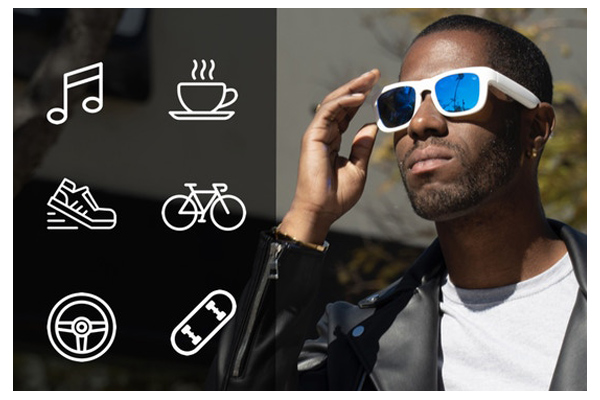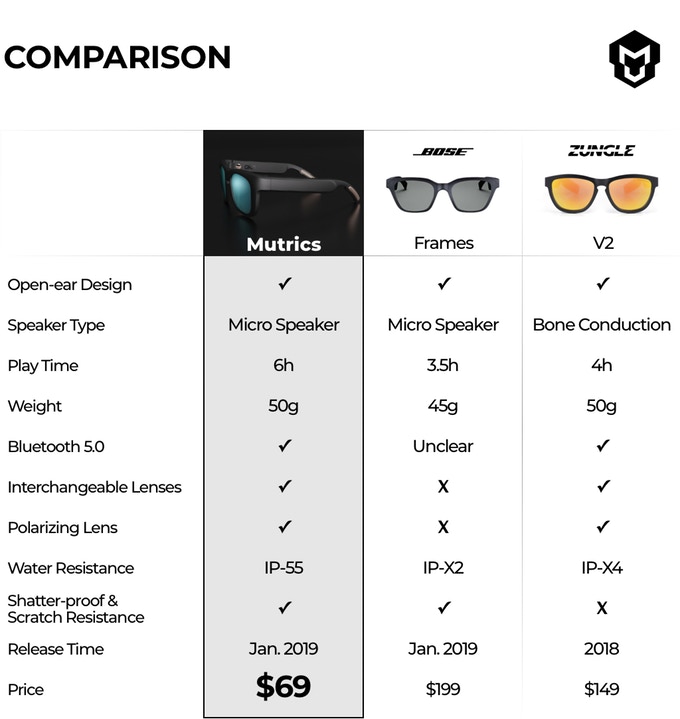Mutrics Smart Glasses Triple Kickstarter Funding Goal with Over a Month Left To Go

Image Credit: Mutrics
Mutrics is a smart glasses Kickstarter project that has reached over three times its funding goal with 53 days left to go. The company’s goal was $5,000 and the total raised to date is $15,245. The project page describes 6-hour play time, open-ear audio, Bluetooth 5.0, one-click control, an adaptable frame, and replaceable lens. The page FAQ states “Mutrics is compatible with all the iOS, Android, and Window smartphones,” and with one click users will be able to access either Siri or Google Assistant. Those who pledge U.S. $69 will receive a pair of Mutrics sunglasses, which have a target price of $129. Of 300 glasses available for $69, there are 124 left, however, there are other deals that provide more glasses for higher donation amounts. The estimated delivery of the glasses is June 2019, and they are available anywhere in the world.
Mutrics are Audio Sunglasses First, Smart Glasses Second
Mutrics sounds very familiar to Bose Frames, in that they are advertised as ‘audio sunglasses’ more than anything else. Users will need to connect a USB Bluetooth dongle to access the glasses’ audio features. Once connected, users can hear audio from their mobile phones while playing video games, and audio will remain completely unheard at arm’s length. The ‘one-click’ feature will provide users with access to either Siri or Google Assistant, power the device on/off, accept or reject calls, play or pause music, toggle the volume, and switch songs.
The glasses will have a magnetic charger and 6-hour playtime capability. Users can replace the glasses lens in order to customize the frames, but they are polarized with UV400 protection by default, and the frames have an IP-55 rating which means they have very limited dust and water ingress protection. The campaign page also features this handy chart to help users compare Mutrics to other smart glasses.

Image Credit: Mutrics
Can Mutrics Stand Out Among the Crowd of Smart Glasses?
Smart glasses are a category of product that has been created by several big-name tech companies and many lesser-known tech companies. Consider how Google Glass was dead upon arrival. Then Google tried to bring it back from the dead in July 2017 but was focused on a second life in enterprise solutions. Curtis Silver, a contributor to Forbes, wrote about Google Glass’ current position in 2019, saying “Google Glass is around in the same way the Microsoft Zune is around because your Dad still struggles to use one…Sure, it might work, but it’s not supported, adapted, or updated.”
LET Vision AI glasses were funded through an Indiegogo campaign in Late 2017 but never made it to market. Intel shut down its entire wearables group in April 2018, including their Vaunt smart glasses. North, the company behind the Alexa-enabled Focal smart glasses then acquired “hundreds of patents and patent applications from Intel’s Vaunt smart glasses portfolio.” In February 2019, Bose announced $199 ‘audio sunglasses’ called Frames that can give audio feedback to users based on GPS location and which way a user’s head is facing but we have yet to see if the software update makes those features possible, as it has yet to be released.
Earlier this week Huawei announced it was working with Korean eyewear and pop-culture influencer Gentle Monster to create stylish smart glasses. This announcement happened at the same event in which Huawei announced pre-ordering the P30 or P30 Pro smartphone in Ireland or the U.K. would get you a free Sonos One speaker. Many details about the glasses are not yet known, but Huawei CEO Hancook Kim is reported to have pushed that these smart glasses won’t look like smart glasses and that the glasses will feature a voice assistant. Huawei’s glasses have a projected launch date of July 2019.
Even Toshiba developed smart glasses for enterprise users, and Vuzix, ODG, Snapchat, Realmax, and MagicLeap have all developed smart glasses too. The point is: smart glasses are being pushed heavily by companies, and there is tough competition out there for Mutrics while user adoption remains an unknown.








